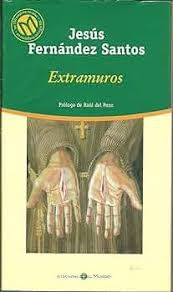
Original language: castellano
Year of publication: 1978
Valuation: Alright
I arrived at Jesús Fernández Santos, maybe someone remembers him, through the Book of memories of thingsa novel published in 1971 about the Protestant communities in Spain. Some time later I decided to Extramuralapparently his most celebrated work, and apparently also made into a film quite successfully. Because it must be said that Fernández Santos is also a man of cinema, who directed documentaries and wrote several scripts, among them precisely that of Extramural. To clarify it better, the text was initially a script for the cinema, which the author later converted into the novel we have here, which is a not very common itinerary, at least in Spain, and may have its importance when evaluating it as a narrative work. .
The plot takes place in a cloistered convent at an indeterminate time that, I don’t know why, I see that some place it in the reign of Philip II. A devastating drought and something that we understand as an epidemic cause the abandonment of the fields and towns, so that the convent, which lives above all on charity, becomes isolated and in an increasingly desperate situation. One of the nuns will devise a trick to attract the attention of potential benefactors, and this triggers the problems that occupy most of the narrative. Although the scenario is not unusual either, the idea can be considered original and opens itself to multiple developments.
If this were specifically a novel, it could perfectly have advanced through an intimate plot, as is largely the case with the one I cited before from the same author, focusing on questions of conscience, guilt or the willingness of the faithful to believe in miracles. . But, of course, let’s remember that this was a film script, and in order not to bore the viewer it was probably necessary to add some spices to give it color and spice. We then find an old prioress (or is it an abbess?) who is devious and envious, flag nuns who dispute without regard, the novice seduced by a quarrelsome monk, or the protective duke who places a wayward daughter in order to keep her away from temptations, or who knows? yes for something else. And, above all, a lesbian relationship inside the cloister.
Let’s remember that we are in 1978, and this involving priests and nuns in erotic matters was something really daring and that sold a lot, which must also be considered. The truth is that Fernández Santos, although he sends signs of this scandalous relationship very early on, does so, at least in the novel, with great care, making it clear but without being too obvious. Being generous, we could even think about whether this layer of the story could be interpreted as a kind of mystical love, an attraction that is to a certain extent intimate and innocent or, seen another way, located in an area of indefinition where it is suggested rather than made explicit.
But here what matters to us is the book, and the problem is that both that love relationship and the rest of the elements that break into the main plot do not contribute anything or almost nothing, they seem like decorations to liven up the narrative, fireworks to avoid focusing. in a story that could be heavy and not very attractive on a screen. So we could perfectly do without them, and also a few characters who seem poorly worked and even with caricature-like features. Only the narrator provides some depth, always insecure, oscillating between her convictions and uncertainty about the final outcome of the deception. And, to say the least, the character of the conspiring nun, seen individually, has a certain interest in her evolution, as long as the reader gives her a reflection that is not always deserved.
What saves the novel from shipwreck is in any case the elegant prose of Fernández Santos, notable moments of those descriptions of desolate landscapes and crumbling walls, always with a tone that I understand is deliberately archaizing, very successful, although it can become saturating in some moments. He is perhaps, as Raúl del Pozo says with unexpected sincerity in the prologue, an author who ‘I wrote more thinking about writing well than about telling stories’. And that, in the field of the novel, can be a problem that is difficult to solve by incorporating effective elements that perhaps can work in other media.
Source: https://unlibroaldia.blogspot.com/2024/10/jesus-fernandez-santos-extramuros.html


